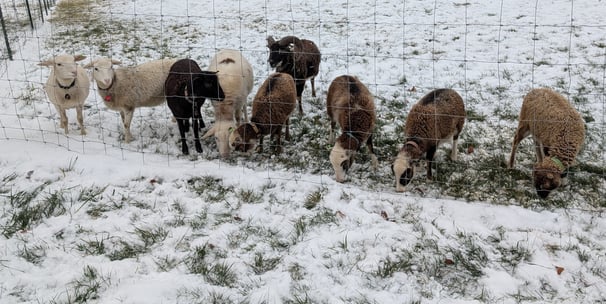Did You Know? Fascinating & Fun Facts About Sheep!
Sheep are some of the most common livestock around the world, but there's much more to these gentle creatures than meets the eye! From their unique physical traits to their surprising intelligence, get ready to discover some amazing and fun facts about sheep.
A Sheep's Eyes are Unique! Did you know sheep have rectangular pupils? This gives them incredible panoramic vision, allowing them to see almost 360 degrees around themselves without turning their heads – perfect for spotting predators! (UC Davis Veterinary Medicine, n.d.)
Four Stomachs, Not One! Like other ruminants (cows, goats, deer), sheep have a complex four-compartment stomach (rumen, reticulum, omasum, abomasum) that allows them to digest tough grasses and hay by fermenting it first. They also "chew their cud" – regurgitating partially digested food to chew it again.
Taking Turns on Watch? While not a formal "shift system," sheep in a flock exhibit collective vigilance. Some individuals will rest or graze while others remain more alert, ensuring that there's often someone on the lookout for danger. This is part of their strong flocking and prey animal instincts.
Excellent Memories: Don't underestimate a sheep's brainpower! Studies have shown that sheep can recognize and remember at least 50 different sheep faces and human faces for more than two years (Kendrick et al., 2001).
No Top Front Teeth! Instead of upper incisors, sheep have a hard "dental pad" on their upper jaw. They use their lower incisors to nip off grass against this pad.
Wooly Wonders: For wool breeds, their fleece will grow continuously if not shorn. The world record for the heaviest fleece shorn from a single sheep (a Merino named Chris) was over 88 pounds (Guinness World Records)! Sheep wool also contains lanolin, a waxy substance that helps waterproof their fleece.
Early to Their Feet: Lambs are incredibly precocious. They can typically stand and walk within just 30 minutes to an hour after being born and are ready to follow their mothers.
Flocking Together: That strong instinct to flock together is a primary defense mechanism. There's safety in numbers, and it makes it harder for predators to single out an individual.
A Global Presence: There are over 1 billion sheep in the world, with more than 1,000 different breeds, each adapted to various climates and purposes! (FAOSTAT; University of Oklahoma, n.d.)
What's in a Name?
An adult female sheep is a Ewe.
An adult male sheep is a Ram.
A castrated male sheep is a Wether.
A young sheep (under one year) is a Lamb.
They Can Self-Medicate (Sometimes!): Research suggests that sheep, when given the choice, will sometimes select plants with medicinal properties if they are feeling unwell, a behavior known as zoopharmacognosy.
Different Sounds, Different Meanings: A mother ewe and her lamb(s) can recognize each other's specific bleats. Sheep make various sounds to communicate different things, from contact calls to alarm calls.
One of the First: Sheep were one of the very first animals to be domesticated by humans, with evidence dating back over 10,000 years (University of Oklahoma, n.d.).
Jumping Ability: While not known for being high jumpers like goats, some sheep, especially lighter breeds, can be surprisingly agile and clear obstacles if motivated!
We hope you enjoyed these fun facts! Sheep are truly remarkable animals, and we love sharing our passion for them.


